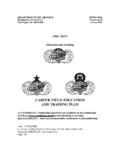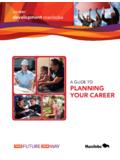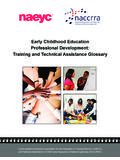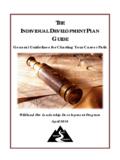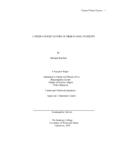Transcription of CAREER FIELD EDUCATION AND TRAINING PLAN - …
1 DEPARTMENT OF THE AIR FORCE CFETP 2T0X1. Headquarters US Air Force Parts I and II. Washington, DC 20330-103 October 2005. AFSC 2T0X1. TRAFFIC MANAGEMENT SPECIALTY. LOGISTIC TRAINING CENTER. LACKLAND AFB, TEXAS. CAREER FIELD EDUCATION AND. TRAINING plan . Table of Contents PART I. Preface_____1. Abbreviations/Terms Explained _____2. Section A, General Information Purpose of the CFETP _____5. Use of the CFETP _____5. Coordination and Approval of the CFETP _____6. Section B, CAREER Progression and Information Specialty Description _____6. Skill/ CAREER Progression _____7. Apprentice Level (3) _____7. Journeyman Level (5) _____7. Craftsman Level (7) _____7. Superintendent Level (9) _____7. TRAINING Decisions _____7. Community College of the Air Force _____7. CAREER FIELD Path _____9. Section C, Skill Level TRAINING Requirements Purpose _____10.
2 Specialty Qualification Requirements _____10. Apprentice Level (3) _____10. Journeyman Level (5) _____10. Craftsman Level (7) _____11. Superintendent Level (9) _____12. Section D, Resource Constraints _____12. Section E, Transitional TRAINING Guide _____13. ii PART II. Section A, Specialty TRAINING Standard _____14. Section B, Course Objective List _____16. Section C, Support Materials _____16. Section D, TRAINING Course Index _____16. Section E, MAJCOM Unique Requirements _____17. Attachment 1, Proficiency Code Key _____18. Attachment 2, STS 2T031/2T051/2T071_____19. Supersedes: CFETP 2T0X1, 1 February 2003 and 2T0X1C1, 1 March 2003. OPR: 345 TRS/DORP. Approved By: HQ USAF/ILGD (CMSgt Carroll). iii ATTACHMENT 2, STS 2T031/2T051/2T071. TRAFFIC MANAGEMENT SPECIALTY. AFSC 2T0X1. CAREER FIELD EDUCATION AND TRAINING plan . Part I. Preface 1.
3 This CAREER FIELD EDUCATION and TRAINING plan (CFETP) is a comprehensive EDUCATION and TRAINING document that identifies life-cycle EDUCATION / TRAINING requirements, TRAINING support resources, and minimum core task requirements for this specialty. The CFETP will provide personnel a clear CAREER path to success and will instill rigor in all aspects of CAREER FIELD TRAINING . NOTE: Civilians occupying associated positions will use Part II to support duty position qualification TRAINING . 2. The CFETP consists of two parts; both parts of the plan are used by supervisors to plan , manage, and control TRAINING within the CAREER FIELD . Part I provides information necessary for overall management of the specialty. Section A. explains how everyone will use the plan ; Section B identifies CAREER FIELD progression information, duties and responsibilities, TRAINING strategies, and CAREER FIELD path; Section C associates each level with specialty qualifications (knowledge, EDUCATION , TRAINING , and other); Section D indicates resource constraints.
4 Some examples are funds, manpower, equipment, facilities; Section E. identifies transition TRAINING guide requirements for SSgt through MSgt. Part II includes the following: Section A identifies the Specialty TRAINING Standard (STS). and includes duties, tasks, technical references to support TRAINING , Air EDUCATION and TRAINING Command (AETC) conducted TRAINING , wartime course, core task, and correspondence course requirements; Section B is reserved in this CFETP; Section C identifies available support materials. An example is a Qualification TRAINING Package (QTPs which may be developed to support proficiency TRAINING ). These packages are identified in the Air Force Master Catalog;. Section D identifies a TRAINING course index supervisors can use to determine resources available to support TRAINING . Included here are both mandatory and optional courses; Section E identifies MAJCOM unique TRAINING requirements supervisors can use to determine additional TRAINING required for the associated qualification needs.
5 3. Guidance provided in the CFETP will ensure individuals in this specialty receive effective and efficient TRAINING at the appropriate point in their careers. This plan will enable us to train today's work force for tomorrow's jobs. At unit level, supervisors and trainers will use Part II to identify, plan , and conduct TRAINING commensurate with the overall goals of this plan . 1. ATTACHMENT 2, STS 2T031/2T051/2T071. ABBREVIATIONS/TERMS EXPLAINED. Advanced TRAINING (AT) Formal course that provides individuals who are qualified in one or more positions of their Air Force Specialty (AFS) with additional skills and knowledge to enhance their expertise in the CAREER FIELD . TRAINING is for selected CAREER airmen at the advanced level of the AFS. Air Force Specialty A group of positions (with the same title and code) that require common qualifications.
6 Bridge Course A formal or informal course of TRAINING which allows the individual to expand his/her knowledge in another area of expertise. CAREER FIELD EDUCATION and TRAINING plan (CFETP) CFETP is a comprehensive core TRAINING document that identifies: life-cycle EDUCATION and TRAINING requirements; TRAINING support resources, and minimum core task requirements for a specialty. Certification A formal indication of an individual's ability to perform a task to required standards. Certification Official A person whom the commander assigns to determine an individual's ability to perform a task to required standards. Core Task Tasks identified by the AFCFM as minimum qualification requirements for everyone within the AFSC, regardless of duty position. Core tasks may be specified for a particular skill level or in general across the AFSC.
7 Guidance for using core tasks can be found in the applicable CFETP narrative.. Course TRAINING Standard (CTS) Identifies the level of TRAINING members will receive in a specific course. Logistics Readiness Enlisted Advisory Group (LREAG). Meets at the direction of HQ. USAF/IL to discuss significant issues, priorities and policies. Provides advice and counsel to HQ. USAF/IL concerning the enlisted logistics readiness community and resolves problems affecting the enlisted force and the overall mission. It also provides recommendations and initiatives for future TRAINING needs, CAREER progression trends, and identifies information systems needs. Exportable TRAINING Course Instructional packages designed for use in the FIELD . The course may include printed, computer-based, or other audiovisual materials. Go/No Go The stage at which an individual has gained enough skill, knowledge, and experience to perform the tasks without supervision.
8 Meeting the task standard. Initial Skills TRAINING A formal school course that results in an AFSC 3-skill level award for enlisted or mandatory TRAINING for upgrade. On-the-Job TRAINING (OJT) Supervised hands-on performance TRAINING conducted to certify personnel in both upgrade (skill level award) and job qualification (position certification TRAINING ). 2. ATTACHMENT 2, STS 2T031/2T051/2T071. Position Qualification TRAINING TRAINING designed to qualify an Airman in a specific position that occurs after upgrade TRAINING . Proficiency TRAINING TRAINING provided to personnel to increase their skills and knowledge beyond the minimum required for upgrade. Qualification TRAINING (QT) Hands-on performance TRAINING designed to qualify an airman in a specific position. This TRAINING occurs both during and after upgrade TRAINING to maintain up-to- date qualifications.
9 Qualification TRAINING Package (QTP) An instructional package designed for use at the unit to qualify, or aid qualification, in a duty position or program, or on a piece of equipment. It may be printed, computer-based, or in other audiovisual media. Resource Constraints Resource deficiencies, such as money, facilities, time, manpower, and equipment that preclude desired TRAINING from being delivered. Specialty TRAINING Standard (STS) An Air Force publication that describes an Air Force specialty in terms of tasks and knowledge an Airman in that specialty may be expected to perform or to know on the job. Also identifies the TRAINING provided to achieve a 3-, 5-, or 7-skill level within an enlisted AFS. It further serves as a contract between AETC and the functional user to show which of the overall TRAINING requirements for an Air Force Specialty Code (AFSC) are taught in formal schools and correspondence courses.
10 Standard An exact value, a physical entity, or an abstract concept, the appropriate authority, custom, or common consent sets up and defines to serve as a reference, model, or rule in measuring quantities or qualities, developing practices or procedures, or evaluating results. A fixed quantity or quality. Supplemental TRAINING Formal TRAINING on new equipment, methods and technology that are not suited for on-the-job TRAINING . Task Certifier See Certification Official. Trainer A qualified individual who teaches personnel to perform specific tasks through OJT. methods. TRAINING Capability The ability of a unit or base to provide TRAINING . Authorities consider the availability of equipment, qualified trainers, study reference materials, and so on in determining a unit's TRAINING capability. TRAINING Session TRAINING that trainers conduct based on technical data for a task that existing courses could not support.










